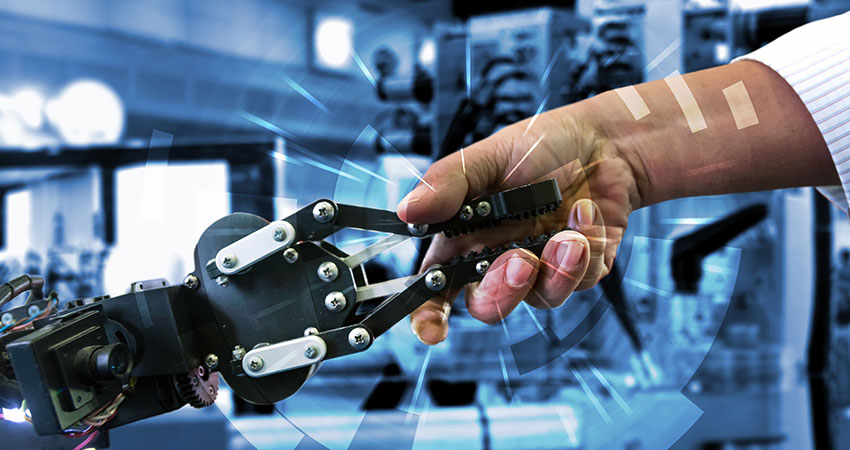While warehousing and logistics is all about moving forwards, it feels like we’re in a time of particular upheaval. The culmination of many of these changes is Industry 4.0, a long-touted concept that’s being more fully realized as technology catches up with ambition.
Widespread implementation of Industry 4.0 might be down the road a bit, but the elements that underpin the concept are slowly being introduced to logistics and warehouse operations worldwide. The question is: What does this concept mean for me, and how can I prepare for this new industrial revolution?
Fourth Time’s the Charm
Perhaps unsurprisingly, the term Industry 4.0 originates in Germany. Coined in 2011 to promote the digitization of manufacturing, it has since grown to encompass the whole supply chain. Earmarked as the fourth great industrial revolution – the first three coming in the 18th, 19th and 20th centuries – Industry 4.0 centers on the use of mobile devices, smart sensors, big data and even augmented or virtual reality to make industry smarter and more efficient.
Industry 4.0 is all about using technology to enhance the fundamental processes involved in logistics and warehouse operations, such as loading and unloading, picking and stock management. This doesn’t just come down to using robots to undertake strenuous or repetitive tasks, however; it’s also about using computers to collect vast amounts of data, and using this to reveal things about your processes and make further improvements.
The use of wireless sensors allows you to assess stock levels more accurately, for instance, and even automate the ordering process. Equally, the actions of both automated devices and human operatives can be more easily tracked. This helps identify areas of inefficiency, whether human error, poor processes or interactions between employees and robots.
Smarter Storage
While most warehouse operations already use some form of WMS, these would be “souped up” under Industry 4.0. The WMS would be the nerve center of a vast digital operation, collecting data and sending out instructions to an army of autonomous, semi-autonomous and mobile platforms. Every task would be catalogued and controlled by the system, with only one or two human operatives keeping an eye on the system.
The benefits to businesses are numerous. Robots receiving a task would be able to act more quickly than people, and know exactly where they needed to go. More accurate inventory management would reduce waste and the potential for over- or understocking, while the delegation of repetitive tasks to robots would pose health and safety benefits. Processes would also be optimized to ensure they were environmentally-friendly, including the use of rechargeable batteries and automated trips to charging stations for robots.
The use of augmented reality devices, such as glasses with heads-up displays, can also enhance the actions of human workers, allowing them to find and pick items or receive instructions more quickly than traditional devices. All of these combined benefits would serve to make logistics and warehouse operations more efficient, a huge step towards the ultimate goal of improving delivery times.
Warehouses will also require design changes to accommodate these new workers and workflows. Some warehouses (or areas of a warehouse) could be altered to cater entirely to robots, resulting in extremely high-density racking and other storage that would not normally be accessible to people.
Getting Your House in Order
Of course, the fact that Industry 4.0 technologies are more widely available doesn’t mean that the revolution is coming tomorrow. It’s likely that if we do see changes across industries, they will come gradually over a number of years, with individual pieces of tech being implemented one at a time. So, is it worth investing in Industry 4.0 tech at all, and if it is, where should you be focusing your attention?
Perhaps the easiest way to start preparing for Industry 4.0 is to consider the dynamics of your space. Reconfiguring your pallet racking may be a good way to get ahead of the curve, both by making it more suitable for robots (reducing bottlenecks or clutter) and more efficient, making space for different types of racking in the future. Pallet racking options such as narrow aisle or double-deep racking could save you more than 50% of the space of your current layout, and can be easily removed, repositioned or adapted to new usage scenarios.
If you do want to go the whole hog and invest in automation, there are a few ways to go about it. One way to trial this technology is to look into automatic storage and retrieval systems (AS/RS), where semi-autonomous robots navigate racking using a system of guided rails. Alternatively, there are a number of firms which now provide robotics as a service (RaaS), where you can rent autonomous robots for your warehouse. The only change you may need to make here is hiring an IT firm to ensure your WMS and IT systems are ready to support them.
While there’s something to be said for tried-and-true methods, automation and other Industry 4.0 aligned technologies are now reliable enough that the biggest operations (Amazon being a prime example) use them every day. Even if they aren’t a perfect fit for your warehouse operations yet, rapid growth in this area means it’s wise to explore the possibility of an upgrade, doing what you can to ensure the transition is as smooth as possible.
James Beale is Operations Manager for Invicta Pallet Racking

